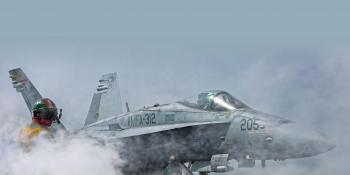READY ROOM
THE STORY BEHIND THE US NAVY HEADLINES
OBSERVERS OF US naval aviation regularly focus on the structure of the carrier air wing (CVW) and how it evolves. Changes are usually small and almost imperceptible, that is until one looks back and realizes how much today’s CVWs have changed from how they looked a decade ago, for example. Looking ahead, the US Navy is planning some big changes as it brings in three new aircraft types on carrier decks and retires another. The complement of aircraft attached to a CVW also is on the rise — set to grow from 66 to 75.
Air wings change as missions change, as aircraft capabilities increase, as type footprints (spotting factor) change, and as the deck size evolves. All of these factors combine to affect the makeup of a CVW.
For two decades since 1950, a CVW usually consisted of five tactical combat aircraft squadrons, initially four fighter squadrons (VFs) and one attack squadron (VA) — shifting to two VF and three VA squadrons — plus various specialized detachments of heavy attack, night attack, early warning (VAW), electronic warfare (VAQ), refueling, photographic reconnaissance, and electronic reconnaissance (VQ) aircraft and helicopters. By the late 1950s,…




